Context of Climate Change and Its Importance
The issues related to climate change have attracted a lot of attention and have become a part of the agenda of socially responsible companies. According to IPCC (2014), there is no doubt about “human influence on the climate system” and its “widespread impacts on human and natural systems” (p. 2). The temperature on Earth has been increasing, and “the period from 1983 to 2012 was likely the warmest 30-year period of the last 1400 years in the Northern Hemisphere” (IPCC 2014, p. 2). Moreover, the surface temperature of both land and ocean has increased by “0.85 [0.65 to 1.06] °C” over the period (Appendix A, Figure a).
Hence, glaciers are shrinking and losing ice mass, and “spring snow cover has continued to decrease in extent” (IPCC 2014, p. 4). Therefore, sea and ocean levels go up (Appendix A, Figure b). Moreover, the rate of sea level rise “since the mid-19th century has been larger than the mean rate during the previous two millennia” (IPCC 2014, p. 4). Thus, the figures show that climate change is evident, and all the changes are related and influence each other.
In terms of climate changes causes, “anthropogenic greenhouse gas emissions” are believed to lead to “2040 ± 310 GtCO2” cumulative concentration of CO2 (IPCC 2014, p. 4). Hence, atmospheric concentrations of carbon dioxide, methane and nitrous oxide have been increasing since 1850 (Appendix A, Figure c). Moreover, greenhouse gas emissions are connected with the growth of industries and transport systems causing a high concentration of CO2 in the atmosphere (Graph 1, Figure d). As a result, these emissions stay in the atmosphere, are preserved in plants, in soils and the oceans.
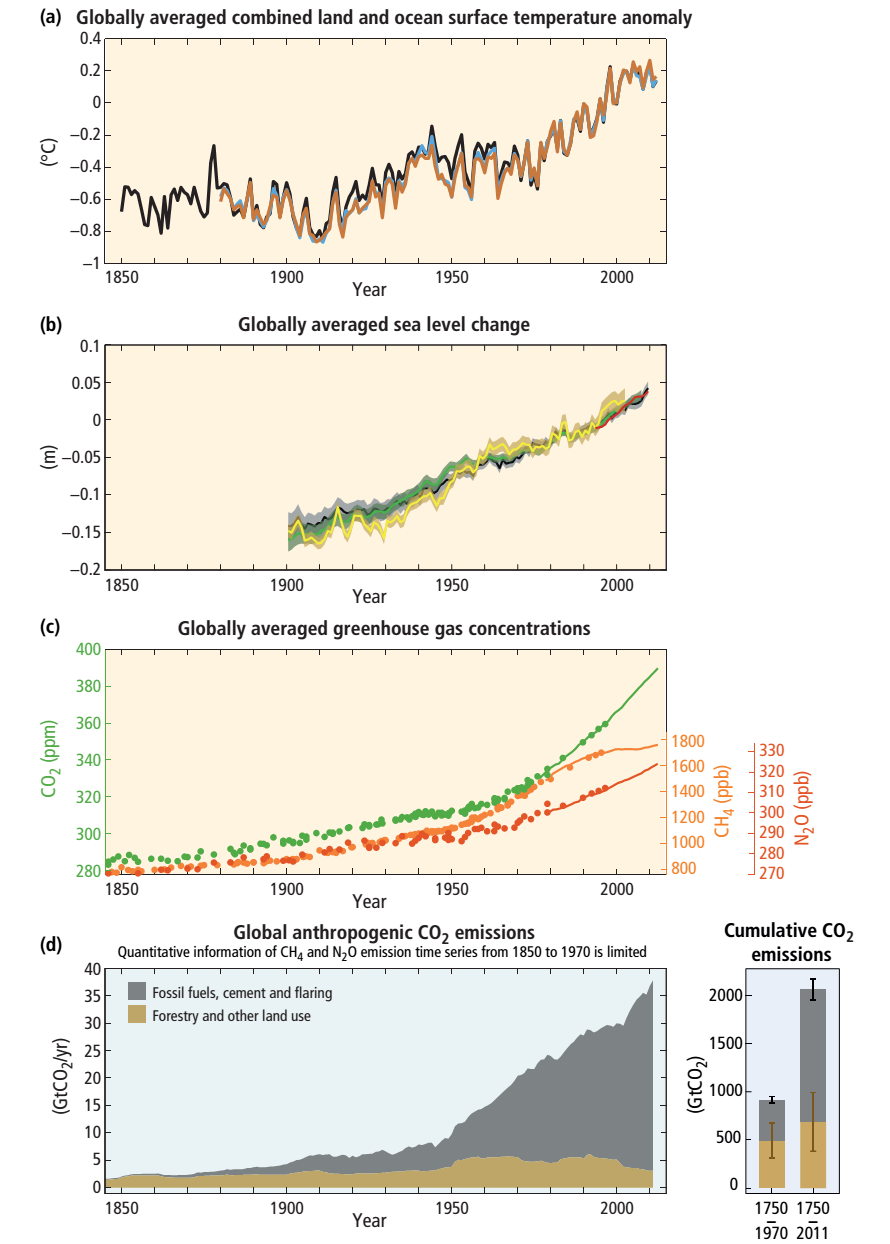
Also, many “extreme weather and climate events” have been observed since 1950, and “some of these changes have been linked to human influences” (IPCC 2014, p. 7). These events include: “a decrease in cold temperature extremes”, “an increase in warm temperature extremes”, “an increase in extreme high sea levels”, “an increase in the number of heavy precipitation events in a number of regions” (IPCC 2014, p. 7). Thus, extreme climate events occur globally irrespective of climate change causes.
Consequently, impacts of changes in climate affect people and nature globally. For example, the hydrological system is affected by sea and ocean level changes, not only in terms of quantity but also quality. As a result, “many terrestrial, freshwater and marine species have shifted their geographic ranges, seasonal activities, migration patterns, abundances and species interactions” (IPCC 2014, p. 6).
Therefore, climate change relate to physical systems (glaciers, snow, ice, rivers, lakes), biological systems (terrestrial and marine ecosystems), human and managed systems (food production, livelihoods, health and economic) affecting all the continents irrespective of the climate changes causes (Graph 2). Hence, short-term and long-term effects of global climate change should be evaluated to develop actions needed to mitigate risks and impacts of the issue.
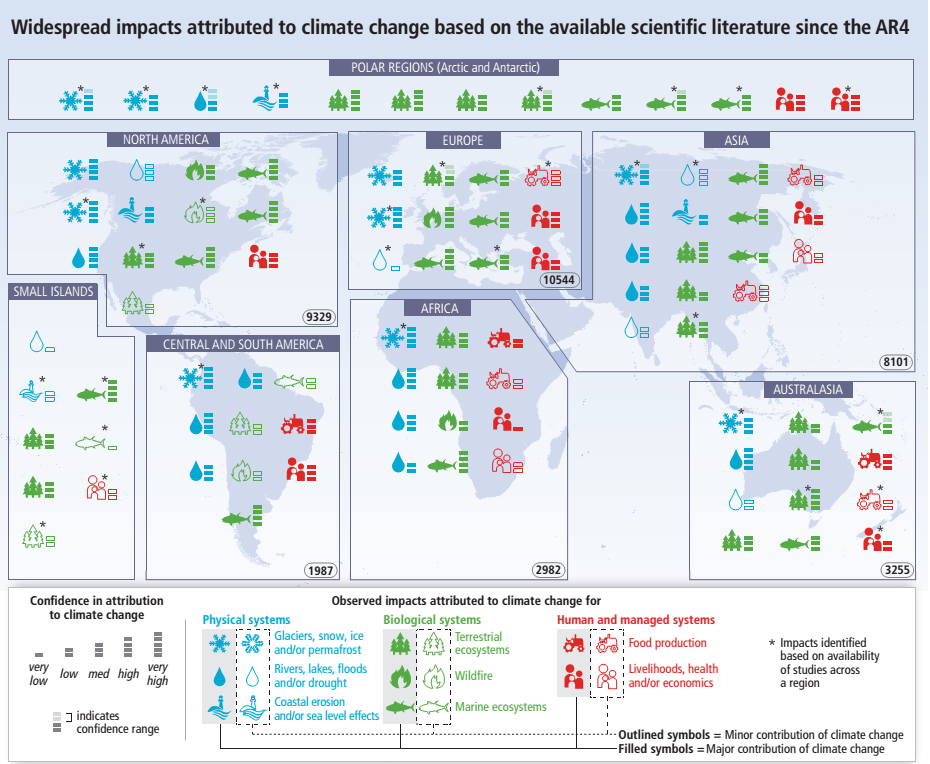
What Changes Are Expected
Climate change predictions and expectations are based on today’s figures and impacts of the climate change. Therefore, future emission of greenhouse gases will lead to further climate warming causing changes in global ecosystems. Hence, “severe, pervasive and irreversible impacts” of climate change will follow (IPCC 2014, p. 8). Namely, climate changes will result in more often and longer heat waves, more intense and frequent extreme precipitation, continued warming and acidifying ocean, rise of global mean sea (IPCC 2014, p. 10).
Hence, scientists testify of drastic changes in average surface temperatures and precipitation levels during 1986-2005 and 2081-2100 due to the climate change (Graph 3). Therefore, expansion of existing risks and creation of new risks for nature and human ecosystems is evident due to current climate changes. Although future impacts and risks of climate change will be distributed unequally, they will be “generally greater for disadvantaged people and communities in countries at all levels of development” (IPCC 2014, p. 14).
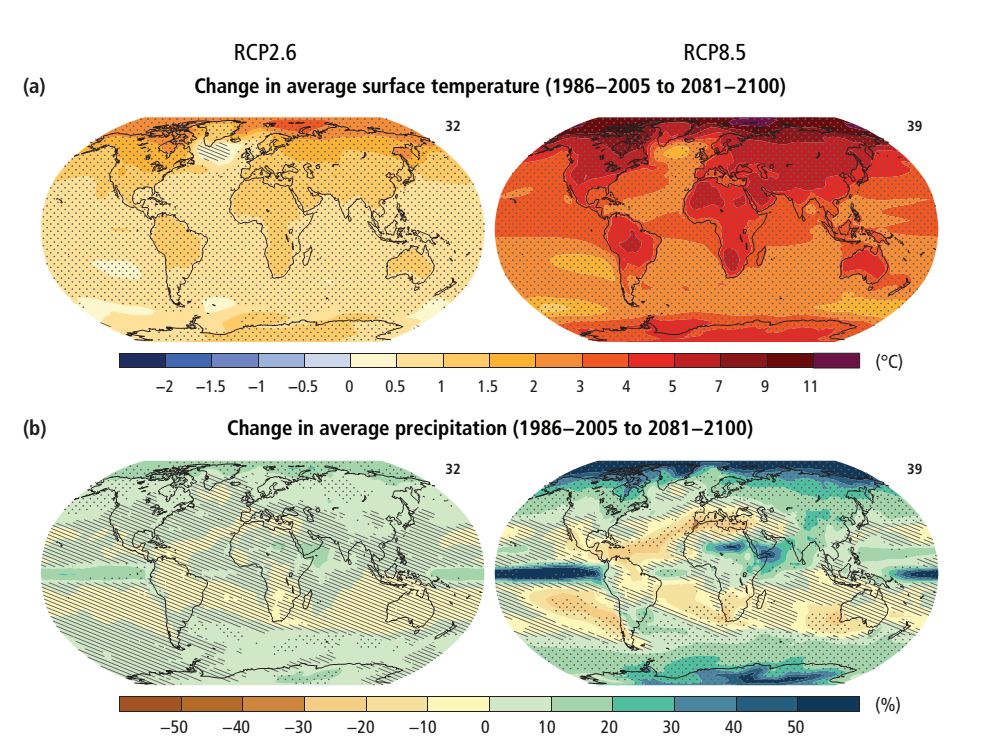
Consequently, some of the critical impacts that follow climate change will affect different regions and ecosystems in the world (Graph 4). Namely, it is highly possible that many species will extinct: plant species that cannot change their geographical position, small mammals, freshwater molluscs, and marine organisms. Besides, coral reefs, polar ecosystems, and coastal systems will be also affected.
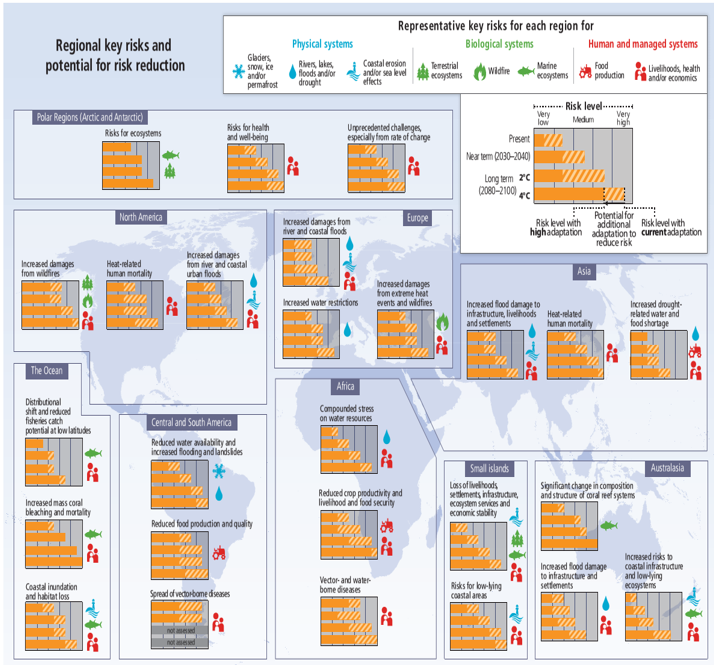
Furthermore, contraction of food security is highly possible due to climate change (Appendix E). Namely, fish production will suffer because of change in “global marine species redistribution and marine biodiversity reduction” (IPCC 2014, p. 15). In terms of agriculture, tropical and other warm regions will experience a shortage of wheat, rice, and maize production because the temperature will increase. However, some North regions will be able to cultivate new plants. However, global clime change is “projected to reduce renewable surface water and groundwater resources in most dry subtropical regions” causing contraction of food security (IPCC 2014, p. 15).
Moreover, in addition to exasperation of health problems, climate changes will cause “increased risks for people, assets, economies and ecosystems, including risks from heat stress, storms and extreme precipitation, inland and coastal flooding, landslides, air pollution, drought, water scarcity, sea level rise and storm surges” (IPCC 2014, p. 15). As a result, climate change impacts will “slow down economic growth, make poverty reduction more difficult, further erode food security and prolong existing and create new poverty traps” (IPCC 2014, p. 16). Hence, hunger and tense relationship between countries in vulnerable regions can lead to an escalation of violent conflicts and wars.
Therefore, environmental actions and initiatives taken are not yet successful. Hence, new mitigation scenarios are vital to being introduced at all levels: global, regional, business, and individual.
Climate Change Mitigation
So far, humans have raised “the average temperature of the planet just under 0.8 degrees Celsius”, and as a result we experience significant increase in sea and ocean levels (McKibben 2012, para. 7). Therefore, after Copenhagen climate conference in 2009, “167 countries responsible for more than 87% of the world’s carbon emissions have signed on to the Copenhagen Accord, endorsing the two-degree target” (McKibben 2012, para. 8).
However, according to some computer models “even if we stopped increasing CO2 now, the temperature would likely still rise another 0.8 degrees, as previously released carbon continues to overheat the atmosphere” (McKibben 2012, para. 9).
Furthermore, scientists believe that there should be “carbon budget” of 565 more gigatons of carbon dioxide “that humans can release into the atmosphere to keep the earth temperature rise under 2 degrees” (McKibben 2012, para. 10). However, “the amount of carbon already contained in the proven coal and oil and gas reserves of the fossil-fuel companies” is already 2,795, which is five times higher than 565 (McKibben 2012, para. 15). Hence, every country should participate in the process of climate change mitigation.
In terms of emissions, the 1997 Kyoto Protocol “delivered an agreement on emission targets, but provided parties to that agreement the discretion to design their own domestic policies necessary to realize those goals” (Aldy & William 2014, p. 5).
Besides, carbon prices vary across countries and signify of each country’s efforts to reduce emissions. However, it is challenging to evaluate carbon prices fairly because “countries implement domestic carbon taxes in their local currencies”, and it is not clear “how to address valuations in these different currencies” (Aldy & William 2014, p. 9). In addition, energy prices give a possibility to assess how a country “engages in fiscal cushioning by simultaneously imposing a carbon tax and source-specific tax relief” (Aldy & William 2014, p. 10). Therefore, the metrics devoted to emission, carbon and energy prices speak of efforts taken to mitigate climate change.
Furthermore, to mitigate global climate change “a broad range of policy instruments will need to be deployed; and action by all countries will be required” (OECD 2008, p.3). Moreover, not only international but also domestic actions connected with emissions, carbon and energy prices are taken into account to analyze successful patterns for mitigation of global climate change impacts.
Consequently, to reduce emission “pricing of GHG emissions” can be done either directly “via carbon taxes” or “through cap-and-trade systems” (OECD 2008, p.3). Hence, the pricing will of GHG emissions lead to “cost-effective emissions abatement and create incentives to innovate and deploy new technologies” (OECD 2008, p.3).
Thus, many companies tend to implement research on the development of ways to reduce adverse impacts of industries on the environment (Where do companies stand on responsible corporate engagement 2014). Being environmentally responsible makes a company more competitive as people tend to buy from such companies. However, only a few companies are actually concerned with the issue. Apart from financial gains, the companies may benefit from investing in research and implementation of environmentally-friendly technologies as this will make them more prepared to climate change that is inevitably coming (Fenech & Maclellan 2007).
Moreover, companies producing and relying on natural resources have to understand that these are non-renewable resources and the companies’ future prospects are quite doubtful (Carter et al. 1994). Thus, oil and gas producers have already started evaluating risks that they will face under climate changes.
What Risks British Petroleum Faces under Climate Change
British Petroleum (BP) is one of the largest oil and gas producers in the world. It provides such products as fuel for transportation, lubricants, petrochemicals, energy for light and heat (BP PLC 2015). Its primary competitors are Exxon, Royal Dutch Shell Plc., and Chevron Corporation. British Petroleum has facilities and subsidiaries in all parts of the world and employs thousands of people worldwide.
There are several business risks that emerge from global climate change. Generally, business can suffer physical, regulatory, reputational, legal, and insurance risks. As BP operates all over the world, it incurs a risk of physical damage of its assets by such climate extreme events as hurricanes, droughts, extreme cold and hot temperatures, and floods. Therefore, BP uses “specialized climate models developed at Imperial College and Princeton” to forecast climate impacts and extreme weather events (Our programme of action to manage climate change risk n.d. para. 6). Hence, BP developed standards to assess climate risks and impacts that might affect their operations.
Furthermore, GHG emissions, design standards, land assessments, and flood designations put BP under regulatory risk. However, BP regularly reports its direct and indirect GHG emissions (Graph 5). According to the last report, its “direct GHG emissions were 48.6 million tonnes (Mte) in 2014 (2013 50.3Mte, 2012 59.8Mte)” (Environment n.d. para. 2). Moreover, being the part of BP’s divestment programme, “Carson and Texas City refineries” sale decreased their GHG emissions (Environment n.d., para. 5).
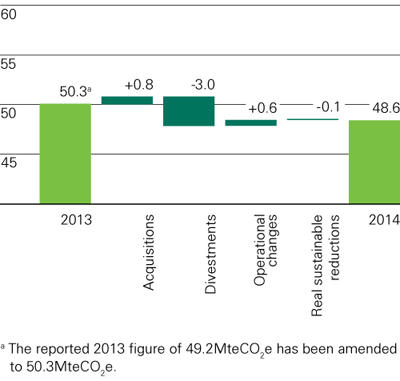
Besides, the company runs a reputational risk and has to develop an image of an environmentally responsible organization to remain competitive in the modern world where communities and are becoming more empowered. For example, BP claims that they manage their GHG emissions “through operational energy efficiency, reductions in flaring and venting, and by factoring a carbon cost into our investment appraisals and the engineering design of new projects” (Environment n.d., para. 4). Namely, in Alaska, BP has “re-injected gas into the reservoir, storing it there rather than flaring it” (Environment n.d., para. 6).
Moreover, BP incurs legal risk and prevents them reporting on its major operations around protected areas “including those designated as protected by the International Union for Conservation of Nature (IUCN) (categories I-IV, V-VI and unassigned), UNESCO World Heritage Sites and sites designated under the Ramsar Convention” (Environment n.d., para. 7).
Finally, climate change is likely to have a considerable effect on BP as increasing temperatures, and decreasing resources will force the company to develop new techniques of production and distribution of its products.
Ways in Which British Petroleum Might Reduce Impacts and Its Contribution to the Climate Change Issue
As any company relying on production of natural resources, BP has a significant effect on the environment and it often negatively affects biodiversity. Thus, BP elaborated “programme of action to manage climate change risk” (Our programme of action to manage climate change risk n.d.).
The first issue is related to lower-carbon energy. BP claims that natural gas is “a plentiful resource that releases less CO2 than other fossil fuels when burned” (Our programme of action to manage climate change risk n.d. para. 1). Moreover, BP possesses technologies that are needed to produce and use natural gas. Hence, around 50% of their current “Upstream portfolio” is natural gas, and BP develops its supply to Europe, China, and India, which is very important because China and India are expected to consume “more than half of the growth in global energy” between 2013 and 2035 (Our programme of action to manage climate change risk n.d. para. 1).
Besides, BP invests in “low-cost, low-carbon biofuels that are either financially self-sustaining now or could be in the future”, doubled “the capacity of our largest sugar cane ethanol facility” in Brazil in 2014, has interests in “16 wind farms, with a total generating capacity of 2,600 megawatts of electricity” (Our programme of action to manage climate change risk n.d. para. 2). Hence, BP is taken solid steps to develop lower-carbon energy.
Furthermore, BP focuses on energy and implements “technologies and systems that could improve energy usage”, for example, by measuring the energy performance by “the Solomon Energy Intensity Index (EII), an industry measure that benchmarks energy efficiencies” (Our programme of action to manage climate change risk n.d. para. 3). As a result, BP provides “energy-efficient” and “high-performance products”, for example, BP’s “Castrol EDGE with Titanium Fluid Strength Technology changes the way engine oil behaves under extreme pressure, reducing friction by up to 15%” (Our programme of action to manage climate change risk n.d. para. 4). Hence, BP cooperates with other manufacturers to develop technologies that allow “more efficient use of fuels and engine oils” (Our programme of action to manage climate change risk n.d. para. 4).
One of BP’s climate change initiatives is an internal carbon price. Namely, BP use carbon cost, for example, “$40 per ton of CO2 equivalent” industrialized countries “as a basis for assessing the economic value of the investment and as one consideration in optimizing the way the project is engineered with respect to GHG emissions” (Our programme of action to manage climate change risk n.d. para. 5). Therefore, BP can adjust to GHG requirements.
Consequently, BP is interested in developing technical innovations to improve the efficiency of its production, “use of fossil fuels and their alternatives” (Our programme of action to manage climate change risk n.d. para. 5). Anticipating impacts of global climate changes, BP examines future energy and new technology trends, supports climate research. For example, BP cooperates with universities, invests in “start-up companies to better understand evolving alternative and advanced technologies such as electric vehicles, battery storage and biolubricants” (Our programme of action to manage climate change risk n.d. para. 7).
Finally, British Petroleum has already invested in “a specialist water treatment company” taking into account “operations’ life cycle water demand and local water resources”, supported businesses “to apply an onshore oil spill modelling tool to improve oil spill response planning”, and developed “energy efficiency” ideas learnt at Toledo in the US (Environment n.d., para. 8).
Nowadays, British Petroleum faces an enormous challenge of satisfying growing demand for energy and at the same time need to assess impacts and future risks of global climate change.
Reference List
Aldy, JE & William, AP 2014, Comparability of effort in international climate policy architecture. Web.
BP PLC 2015.
Carter, TR, Parry, ML, Harasawa, H, Nishioka, S 1994, IPCC technical guidelines for assessing climate change impacts and adaptation. Web.
Environment n.d.
Fenech, A & MacLellan, J 2007, ‘Rapid assessment of the impacts of climate change’, in A Fenech & J MacLellan (eds), Linking climate models to local decision-making, Environment Canada, Toronto, pp. 83-131.
IPCC 2014, ‘Climate change 2014: Synthesis report’, in Core Writing Team, Pachauri RC & Meyer LA (eds), Contribution of Working Groups I, II and III to the fifth assessment report of the Intergovernmental Panel on Climate Change, IPCC, Geneva.
McKibben, B 2012, ‘Three simple numbers that add up to global catastrophe – and that make clear who the real enemy is’, RollingStone. Web.
OECD 2008, Climate change mitigation: What do we do.
Our programme of action to manage climate change risk n.d. Web.
Where do companies stand on responsible corporate engagement in climate policy? 2014. Web.